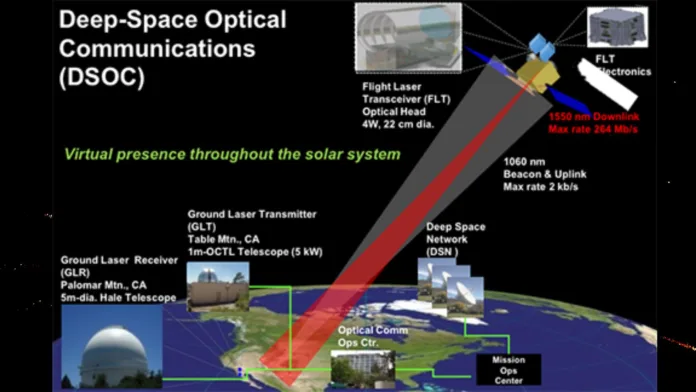Summary
- Discover how NASA achieved a first in Deep Space Communication by sending a video of a cat from 18.6 million miles away.
- Modern Discover more about the groundbreaking Deep Space Optical Communications experiment, or D.S.O.C.
- The purpose of the Psyche mission is to learn how the Psyche spacecraft advances communication technology.
- Explore NASA’s ambitious plans to send data ten times farther in the upcoming months by reading “Future Frontiers.”
Table of Contents
Transforming Communication Beyond Earth’s Orbit
Correspondence has forever been difficult for researchers and designers in the immense breadth of the room. On December 11, NASA arrived at a turning point at the Stream Drive Lab in Pasadena, California. Engineers were enthusiastically anticipating the transmission of a feline video as a feature of NASA’s Profound Space Optical Interchanges (D.S.O.C.) experiment.
The Cat Video That Defied Gravity
NASA engineers successfully streamed a high-definition video of a cat named Taters from 18.6 million miles away, signaling a significant advancement in deep space communication capabilities.
A Communication Revolution
This accomplishment demonstrates the advancements in optical communication technology, which is critical for future human missions beyond Earth’s orbit.
The Experiment’s Role in D.S.O.C.
The D.S.O.C. experiment employs laser communications rather than traditional radio frequencies, intending to transfer large amounts of data at faster rates over longer distances.
Related Topic: NASA’s Laser Breakthrough: Paving the Way for Faster Deep Space Communications
The First Step in Overcoming Difficulties
While the communicated information speeds of 267 megabits per second compete with those on the planet, project technologist Dr. Abhijit Biswas emphasizes the fundamental idea of this accomplishment. The ground framework still has a lot of work to do before it can be considered a solid functional framework.
Framework Parts of D.S.O.C.
The D.S.O.C. framework is comprised of three parts: a flight laser handset on the Mind rocket, a ground laser transmitter, and a ground laser collector at the Palomar Observatory in Southern California.
Pushing the Boundaries
The D.S.O.C. project’s next challenge is to transmit from a distance ten times greater—186 million miles—a testament to the project’s lofty goals.
A Look Towards the Future: Tenfold Transmission
NASA engineers hope to push the boundaries even further by the end of June, with plans to transmit data from an unprecedented distance of 186 million miles.
NASA’s Technological Advancement Commitment
NASA Deputy Administrator Pam Melroy emphasizes the importance of increasing bandwidth to meet future data transmission requirements for exploration and scientific goals.
Contribution of the Psyche Mission
The Psyche mission, launched on October 13, is critical to the success of the D.S.O.C. experiment, demonstrating the potential for higher-data-rate communications.
Feline Frequency: Taters, the Showstopper
Taters, an orange tabby cat, chased a laser pointer in the high-definition video. The video, which was sent faster than most broadband internet connections, exemplifies the effectiveness of deep-space communication.
Create a Memorable Video
The video overlays Psyche’s orbital path, Palomar’s telescope dome, and technical information about the laser in a nod to television test transmissions featuring Felix the Cat in 1928.
Record Data Downlink Speeds
Downlink bit rates of 62.5 Mbps, 100 Mbps, and 267 Mbps were achieved, which are comparable to broadband internet download speeds.
Deep Space Optical Communications Demonstration
NASA’s ongoing efforts to advance optical communication technology include the D.S.O.C. demonstration. It intends to transmit data from deep space at rates tens to hundreds of times faster than current radio frequency systems.
Technological Achievements
The successful transmission of the cat video comes on the heels of the achievement of “first light” on November 14, which demonstrated faster data downlink speeds and increased pointing accuracy.
The Road to High-Data-Rate Communications
The D.S.O.C. project paves the way for the transmission of complex scientific data, high-definition imagery, and video, enabling humanity’s next great leap in space exploration.
Conclusion: A Significant Advance in Deep Space Communication
NASA’s success in streaming a cat video from 18.6 million miles away demonstrates the advancements in deep space communication. The D.S.O.C. project, as technology advances, lays the groundwork for unprecedented data transmission, shaping the future of interplanetary communication.
FAQs (Frequently Asked Questions)
Q. 1. What is the significance of a cat video being streamed in deep space?
A. 1. The video transmission of a cat demonstrates the capabilities of NASA’s Deep Space Optical Communications experiment, demonstrating advancements in communication beyond Earth’s orbit.
Q. 2. What is the D.S.O.C. system?
A. 2. To achieve high-data-rate communication, the system employs a flight laser transceiver on the Psyche spacecraft, a ground laser transmitter, and a ground laser receiver.
Q. 3. What are the D.S.O.C. project’s challenges?
A. 3. Despite successful transmissions, the project recognizes the need for additional ground infrastructure development to ensure operational reliability.
Q. 4. What role does the Psyche mission play in this endeavor?
A. 4. The Psyche mission is critical to the D.S.O.C. experiment, as it contributes to the exploration of an asteroid and the testing of communication technologies.
Q. 5. How does the D.S.O.C. project intend to push its boundaries in the future?
A. 5. By the end of June, NASA engineers hope to transmit data from ten times farther away, putting the project’s capabilities to the test and pushing the limits of deep space communication.
Disclaimer:
AI was used to conduct research and help write parts of the article. We primarily use the Gemini model developed by Google AI. While AI-assisted in creating this content, it was reviewed and edited by a human editor to ensure accuracy, clarity, and adherence to Google's webmaster guidelines.


